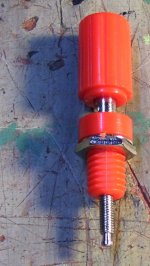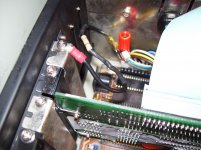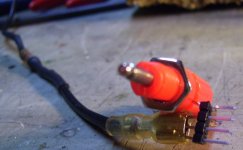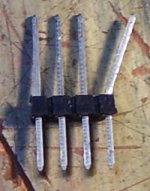sombunall
Experienced Member
I managed to make a really sweet hack for an XT reset switch for my original IBM XT mobo. Do do this hack you need:
banana terminal with 2mm screw
ground wire with round type lug on one end and normal lug on other end
header pin bus (I think it's called that)
soldering iron / shrink wire
100 to 150? ohm resistor
On an XT/AT power supply connector to the motherboard you have power_good which usually is pin 1 and white. According the Repairing and upgrading PCs 5th edition you can do a crude reset of the PC by grounding this pin using 1k to 2.5k resistor. Connecting directly to ground could blow the transistor. I tried and could not reset the computer with anything higher than about ~150 ohms (I only tested up to 110 ohms!). So I chose a 110 ohm resistor I had (it's an oddball value). Why crude reset? If you unplug the keyboard and plug in another the reset will not reset all chips like in an AT so you will need to turn the computer off. This reset will work as long as the other chips with reset pins do not get borked.
You can screw the banana terminal into the back end of where the power_good wire comes out.
As for the header pins you will need to cut off 4 pins (hacksaw actually) from a line of them that you buy from Digikey for example. Then you will need to bend one of the pins on the end (the long end) in order to make sure it does not contact the one beside it when you insert it into the hole of the banana connector.
So once you solder in and shrink wire the resistor in series on the wire you just screw the round type lug to one of the expansion card screws that secure it to the case.
If anything is missing with this guide please tell me.
This guide was typed up on my XT with monochrome amber monitor on a paradise EGA card set to 43 rows text inside a telix terminal connected by null modem to a debian linux server. It was typed up on nano. The file was then imported into ultraedit32, converted from unix to DOS to change 0A to 0D 0A, trailing spaces were removed and then CR/LF was converted to a soft wrap. Hopefully I remembered to spell check. Thank you.

banana terminal with 2mm screw
ground wire with round type lug on one end and normal lug on other end
header pin bus (I think it's called that)
soldering iron / shrink wire
100 to 150? ohm resistor
On an XT/AT power supply connector to the motherboard you have power_good which usually is pin 1 and white. According the Repairing and upgrading PCs 5th edition you can do a crude reset of the PC by grounding this pin using 1k to 2.5k resistor. Connecting directly to ground could blow the transistor. I tried and could not reset the computer with anything higher than about ~150 ohms (I only tested up to 110 ohms!). So I chose a 110 ohm resistor I had (it's an oddball value). Why crude reset? If you unplug the keyboard and plug in another the reset will not reset all chips like in an AT so you will need to turn the computer off. This reset will work as long as the other chips with reset pins do not get borked.
You can screw the banana terminal into the back end of where the power_good wire comes out.
As for the header pins you will need to cut off 4 pins (hacksaw actually) from a line of them that you buy from Digikey for example. Then you will need to bend one of the pins on the end (the long end) in order to make sure it does not contact the one beside it when you insert it into the hole of the banana connector.
So once you solder in and shrink wire the resistor in series on the wire you just screw the round type lug to one of the expansion card screws that secure it to the case.
If anything is missing with this guide please tell me.
This guide was typed up on my XT with monochrome amber monitor on a paradise EGA card set to 43 rows text inside a telix terminal connected by null modem to a debian linux server. It was typed up on nano. The file was then imported into ultraedit32, converted from unix to DOS to change 0A to 0D 0A, trailing spaces were removed and then CR/LF was converted to a soft wrap. Hopefully I remembered to spell check. Thank you.
Attachments
Last edited:








